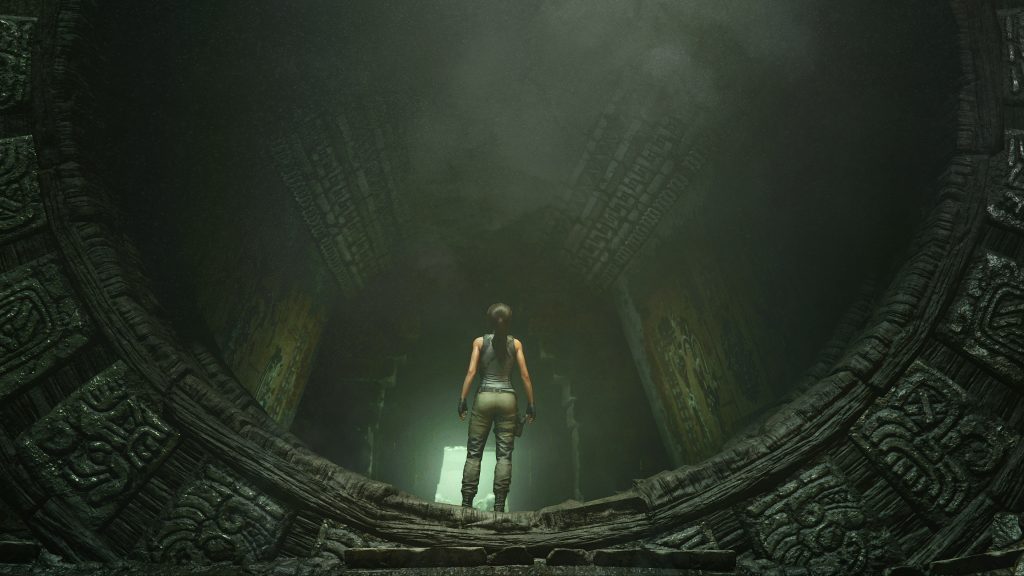Video Gamer is reader-supported. When you buy through links on our site, we may earn an affiliate commission. Prices subject to change. Learn more
The following article contains mild spoilers for Shadow of the Tomb Raider, which pertain to a section that occurs early on.
Over the last three Tomb Raider games, an excavation has been underway. Digging into the depths of Lara Croft’s heart, they have all sought to see just who this video game icon really is, to find out what – be it blue blood or Lucozade – courses through her veins. As it happens, it was never a job for an archaeologist. What you need is a meteorologist.
This trilogy has seen Croft’s indomitable spirit buffeted by storms in a gap year gone wrong, annealed and numbed in sheets of Siberian ice, and dredged up in the murk of a mudslide. Whether it be rain, snow, or a downpour of bullets, her resolve has been plagued with precipitation. She speaks, care of Camilla Luddington, with the haggard frustration of an outdoorsman let down, once again, by the weather. But due to the demands of the modern action video game, she is as elegant and murdery as she ever has been. Her identity is caught in a cloudy crosscurrent, pulled between then and now, survivor and predator, woman of flesh and weapon of style.
Despite the foggy forecast, there is, in Shadow of the Tomb Raider, a brief opening of the clouds. The game’s best level comes covered not in the dust of a dig site, but in the dust that floats in the wake of Croft’s dreams. Early on, she nods off at a campsite and journeys back to her childhood home, where you take control of a young Lara, before spike-laden pits became a part of her pasttimes. As she capers across a climbing set and shinnys up a drainpipe, the house creaks under the weight of time. Croft Manor has stood in stately grace since the very first game, in 1996; but what was once a chilly reminder of Croft’s privilege is now a symbol of her pain. The house is a bridge between two Laras.
The Lara we have now sprang from Rhianna Pratchett’s pen, and 2013’s Tomb Raider was a game as unsure of its core design as its heroine. Early on, it was caked in cruddy realism; her ship crashed off the shore of an island in the pacific, leaving her and the crew to contend with some unfriendly locals. It looked as if the game might play it straight: no mystical MacGuffins, just a castaway with a cadre of thugs on her tail. But as the game wore on, our heroine was hooked by the supernatural, which seemed a remnant of games gone by, something this Lara hasn’t the time or temperament to contend with – there are quite literally wolves at the door, after all.
By the time the next game, Rise of the Tomb Raider, came along, she was well down the rabbit hole. Her father’s ex, Ana, warns her not to follow in his footsteps: ‘It’s all fairytales. Nonsense,’ she warns Lara. ‘Don’t go down this road. You know where it leads.’ Perhaps Pratchett felt a similar familial pull, lured by the magic in her father’s tales. So it was that Lara became transfixed not with the musty thrill of tomb raiding for its own sake but with the raiding of her father’s legacy. Gone was the clipped cool of Crofts gone by, replaced with rabid desperation and ferocious firepower.
Taking over from Pratchett, for Shadow of the Tomb Raider, is Jill Murray, whose writing credits include Assassin’s Creed III: Liberation and the Freedom Cry DLC for Assassin’s Creed IV: Black Flag. They were both side stories of the unsung stepping into the spotlight, a fitting theme for the young Croft, whose quest in Shadow of the Tomb Raider’s dream sequence is to ‘prove herself worthy of becoming Lord Richard Croft’s assistant.’ It’s the only scene free from the po-faced drizzle on offer everywhere else in the trilogy, and Murray’s writing glows in small, moving moments. ‘Lara climbs out over the lava,’ she narrates, as she hot foots it along a narrow beam above the garden grass. She hurls balls at targets, hurtles down slides, and clambers into a wooden pirate ship. Her life is a game.
Or at least, it could have been. The flashback offers a glimpse of how the high-born gadabout, who yearns for the release of adventure, becomes the limping survivor, dashed against its jagged rocks. It’s when she enters the house that we begin to notice just where we are. The Aztec trinkets, the armour, and the artifacts: all relics of her father’s obsession. There are no monsters to fight but the quiet, as she goes about pushing blocks into place on an enormous puzzle board. You see the stripped bones of a T. rex seized in a glass display case – an icon from the life of a different Lara. It’s when the dream ends with the crack of a gunshot that you realise: you’re in a tomb, one that houses what might have been of the Lara we once knew.



